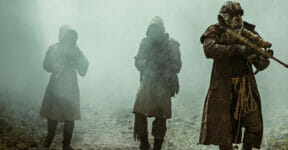Sci-Fi Horror Books- A List of Hidden Gems
People are good at recommending new stuff and singing praises to an already popular sci-fi horror book. But if you’ve already consumed a sizeable dose of the easily recognizable titles and bestsellers, it might be time to scour the aisles for a few unsung gems of the genre. And who knows, maybe in the dimly lit corners of the genre’s vastness, you’ll come across some of the best sci-fi horror books you’ve never expected to find.
Underrated Sci-Fi Horror Books List
Think you’ve explored the darkest corners of sci-fi horror literature? Think again! We’ve unearthed a treasure trove of underappreciated gems that blend futuristic dread with spine-tingling scares. Get ready to expand your reading horizons with these fantastic, yet often overlooked, books.
Feed (2010) by Mira Grant
Zombies are undoubtedly popular, but sometimes you might find yourself tired of them. You still like zombies mostly, you just wish there’s something new about the walking undead. Well then, in that case, the 2010 novel “Feed” by Mira Grant is exactly what you need. The story is set in the near future after the wandering corpses appeared just about everywhere. Unlike in most zombie stories, however, the government has so far stayed more or less functional in Feed. While the government can’t possibly function to their full potential, the society at large is at least on their side to fight back against the undead. They’ve implemented safety protocols to protect the living and maintain normalcy as best they could, with some glaring exceptions: everyone has to undergo a lot more blood tests and bleach showers to make sure that the infected can be identified right away.
After going through a few early chapters, you’ll soon realize that the zombies are merely used as a backdrop of the story. Feed really is about the concerns over privacy and how fear has become a powerful force to give up on the government entirely. It’s the story of Georgia and Shawn, a team of amateur journalists who have just been given an all-access pass to a presidential campaign–but what they discover during their short tenure is much more intriguing than they dare imagine.
Woman on the Edge of Time (1976) by Marge Piercy

Connie Ramos is now in a mental health facility and scheduled for a potentially mind-altering brain surgery, courtesy of her niece’s villainous pimp. What most people don’t know is that Connie is now teaming up with Luciente, who arrives from the future, to rebuild the world. Luciente is not your ordinary time-traveler; this person comes from a post-apocalyptic, utopian society that has already abandoned the old-tradition of gender roles. Connie enjoys her time in the future, where she gets to experience a true peaceful life in a communal living surrounded by poly-amorous population, festivities fueled by recreational drugs, and small-scale agriculture.
But the utopian peace where the genderless people are all sleeping with each other is under a threat. A much darker patriarchal regime driven by organ harvesters is hellbent on taking over the otherwise fantasy-like land of the future. Connie joins the resistance, and this development sets the novel into an exploration of various political ideologies–some are much more radical than others. In short, Women on the Edge of Time isn’t your run-of-the-mill novel–it’s definitely speculative fiction involving time travel, with just enough touches of horror here and there.
The Kraken Wakes (1953) by John Wyndham

While not as well known as The Chrysalids (1955) or The Day of the Triffids (1951), the alien invasion story in The Kraken Wakes makes for an excellent companion to John Wyndham’s more popular novels. The narrative is told from the perspective of a regular English couple, which allows Wyndham to keep the true form of the alien unknown throughout the novel. It also helps that this mysterious creature roams around the deepest parts of the ocean. In some sense, the alien is almost similar to the shark in Jaws; you never catch a clear description of its appearance and what it’s actually doing.
By delivering the story through characters far removed from where the monster is, The Kraken Wakes sets a good example of how NOT to repeat the same old alien invasion narration as laid down by HG Wells, while still adhering to the escalating-panic trope as observed in The War of the Worlds (1898). One of the best things about The Kraken Wakes is how utterly believable the protagonists are; their conceit and bewilderment work together so well, making the novel an effective and original take on an otherwise well-worn premise.
Blood Music (1985) By Greg Bear

Outbreak trope in sci-fi horror is nothing new. Mary Shelley published The Last Man in 1826 and Stephen King delivered one of the most popular takes on the trope in The Stand (1978). Plenty of other novels offered their own unique narrative styles on the same premise, but not all of them have enjoyed their well-deserved fame; one of such novels is Blood Music, published in 1985, written by Greg Bear. During a time when cybernetics were still all the rage in the 1980s, Blood Music came up with a glorious blend of science fiction and horror by combining the speculative biological computers with the already popular outbreak trope.
The story concerns Vergil Ulam, a biotech professional who creates some kind of microscopic lymphocyte-based computers. When he no longer feels safe about the state of his employment, Vergil injects those biological computers into his body to smuggle out the technology. Little does he know the computers are, in fact, sentient and developing advanced societies inside his body. The combination of self-aware computers and Cronenberg’s body horror style did earn Blood Music a Hugo Award nomination, but the novel has been largely neglected by the popular culture just as soon as Greg Bear published his Nebula-winning work, Moving Mars, in 1993.
Damnation Alley (1967) – Roger Zelazny

The story is pretty simple here: the world has been almost destroyed by a nuclear war, and America has transformed into a police state. Meanwhile, Boston is ravaged by a killer plague and in desperate need of a vaccine. The problem is that the vaccine is still in L.A. Somebody must drive through a stormy wasteland frequented by marauders and mutants to deliver it.
Everyone knows that it’s likely a one-way trip with no guarantee of success. No one will do it, except Angel, a convicted criminal. His only reward is a pardon, assuming he survives. Probably best remembered from its film adaptation, which failed to do the novel justice, Damnation Alley is filled with a relentless ride full of fascinating imagery and set-pieces. That said, it remains lean and fast-paced for a truly enjoyable sci-fi horror action read.
We think you can always dig deeper into the back catalog of sci-fi horror books and discover an enormous pile of underappreciated novels. There can be many reasons good novels fall into obscurity; poor marketing effort, getting drowned by rapid releases of new books, terrible film adaptation, etc. In all honesty, we do not know how the novels mentioned above simply slipped through the cracks and never really enjoyed their well-deserved popularity.
What do you think is the most popular sci-fi horror book ever? If you have to name one overrated sci-fi horror movie, what would that be? We’d love to hear from you.
Other Things You Might Want to Know
Isn’t Damnation Alley also a film?
Yes, it’s a 1977 film loosely based on the novel. It’s said that Zelazny actually liked the original script for the film written by Lukas Heller, because it was acceptably faithful to the source material. Unfortunately, the filmmaker used a different shooting script, written by Alan Sharp, which took too much liberty and deviated to a great degree from the novel.
Some popular novels by John Wyndham:
- The Secret People (1935) – pseudonym: John Beynon
- Foul Play Suspected (1935) – pseudonym: John Beynon
- Planet Plane (1936) – pseudonym: John Beynon. Planet Plane was later republished as Stowaway to Mars and The Space Machine
- The Day of the Triffids (1951)
- The Kraken Wakes (1953)
- The Chrysalids (1955)
- The Midwich Cuckoos (1957)
- The Outward Urge (1959) – a collection of four novelettes and a short story
- Trouble with Lichen (1960)
- Chocky (1968)
- Web (1979) – posthumously published
- Plan for Chaos (2009) – posthumously published
A few science fiction and horror anthologies to enjoy:
- Strange Ports of Call (1948, edited by August Derleth)
- Science Fiction Terror Tales (1955, edited by Groff Conklin)
- Terror In a Modern Vein (1955, edited by Donald A. Wollheim)
- The Berserkers (1974, edited by Roger Elwood)
- In Space No One Can Hear You Scream (2013, edited by Hank Davis)
- The Baen Big Book of Monsters (2014, edited by Hank Davis)








